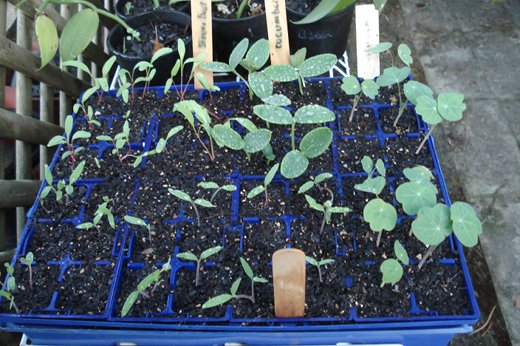We have started planting our new season vegetable garden. We do our main planting in March and continue planting until November. Depending on the weather, we usually keep harvesting until late December. The soils are then left to rest for two months and we start the cycle again in March. Organising our gardening like that gives the soil a chance to rest but it also lets us rest too over the hottest months. This system works well for us.
Every time we replant, be that at this main March planting or during the year with our numerous succession plantings, we enrich the soil with organic matter like compost, manures and worm castings. During the year we also dig in any straw mulch that is still on the surface, that gives the soil good structure.
This is the most important thing I will write about planting today: you must enrich your soil before you plant and every time you replant. No amount of fertiliser later in the year will make up for not doing this. Placing your plant roots in rich, fertile soil really pays off. If you're digging a new garden, you'll probably spend a week or two getting your soil ready before you plant. This is not wasted time, it is a time honoured way of working with your organic garden and is an investment in your future harvests.
We plant both seedlings and seeds. Most of our root crops are planted as seeds, so this includes carrots, turnips, radishes, beetroot, swedes (rutabaga), parsnips. We plant potatoes and sweet potatoes as sprouting tubers. Garlic goes in now in our climate - I have stored ours in a brown paper bag in the crisper of the fridge for a couple of weeks to mimic a cold winter. When the garlic is planted, it "thinks" it's Spring and grows as if it's coming out of a cold winter. Garlic takes a long time to mature. When the green tops emerge above the soil, you'll see them for a long time until they start going brown and dying back. That is usually when they're ready to harvest.
We plant kale as both seedlings and seeds but most of our leafy greens are grown as seedlings. This includes Chinese greens like pak choi and lombok. We plant many more than we will eat and share because the chooks love them too. They grow fast - eight weeks and they're ready, so there is a constant supply. We replant Chinese greens all through the year. The leafy green category also includes lettuce, silver beet (chard), spinach, cabbage, brussel sprouts.
Flowering vegetables and fruit such as tomatoes, beans, peas, cucumbers, cauliflower, broccoli, zucchinis are planted as seeds in trays, raised as seedlings, and are then planted out in the garden. There is a post about how we plant tomatoes here. They're an important crop for us and if we take a bit of care with them we reap the benefits. In our climate it's too cold for capsicum, eggplant, corn or pumpkins right now. We keep our capsicum bushes going, but don't expect them to produce anything until it warms up again.
Basically, root crops don't like too much manure, especially not clumps of it, and nothing fresh. Leafy greens like a lot of nitrogen, so they love enriched soil with plenty of manure. Flowering vegetables like sulphate of potash to help with flowering and root structure, but don't give them too much nitrogen because you'll get a lot of leaves and very few vegetables. Most vegetables love being mulched, but they don't like the mulch touching their stems. The exception to this rule is tomatoes - they love mulch touching their stems and a nice thick layer of mulch built up along the lower part of the stem. Make sure the lower leaves on the tomatoes are pricked off.
All seedlings like a good watering as soon as they're planted and if you have some seaweed concentrate, make up a seaweed tea and use that to water in. The plants will love you for it. Tomorrow we'll talk about making your own fertilisers at home. This increases your level of self reliance and also gives you excellent harvest at little cost.
At the moment our vegetable garden is a mess of half-prepared beds and weeds but it won't take long to get it back to full production. It's something both Hanno and I are very excited about this year. We expect to bypass the high prices and often inferior quality in supermarkets and produce our own fresh organic vegetables. And this year, more than ever, it's important that we succeed with every crop. If you have the space I encourage you to do the same. What are your garden plans this year?
At the moment our vegetable garden is a mess of half-prepared beds and weeds but it won't take long to get it back to full production. It's something both Hanno and I are very excited about this year. We expect to bypass the high prices and often inferior quality in supermarkets and produce our own fresh organic vegetables. And this year, more than ever, it's important that we succeed with every crop. If you have the space I encourage you to do the same. What are your garden plans this year?



